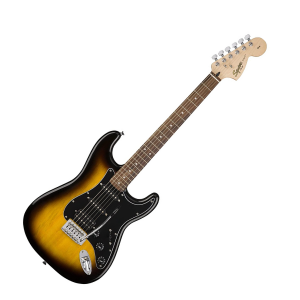
- Body Material – Poplar
- Bridge System – Tremolo
- Guitar Pickup Configuration – Combination
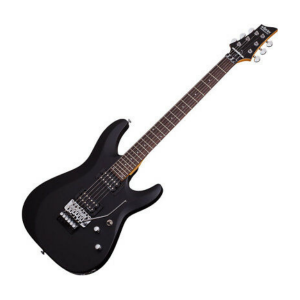
- Body Material – Basswood
- Bridge System – Tune-O-Matic
- Guitar Pickup Configuration – Humbucker
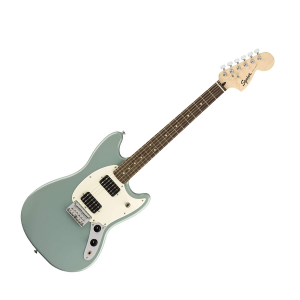
- Body Material – Poplar
- Bridge System – Hardtail Bridge
- Guitar Pickup Configuration – Humbucker
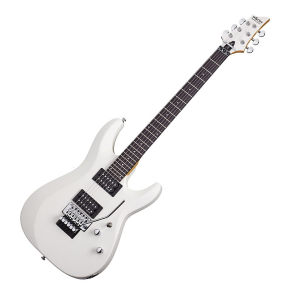
- Body Material – Basswood
- Bridge System – Tremolo
- Guitar Pickup Configuration – Combination
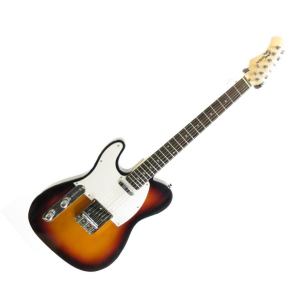
- Body Material – Alder
- Scale Length – 25.5 Inches
- Guitar Pickup Configuration – Single Coil
Choose the Best Guitar for Metal Under $300
Customer’s Choice: the Best Rated Guitars for Metal Under $300
24 users answered this survey. Please help us improve this review!
Table of Contents
Best Guitars for Metal under $300 – Buyer’s Guide
Types and features
When buying a guitar for metal under $300, the first thing to consider is what type of guitar to buy in the first place. Depending on the tone production, a distinction is made between acoustic guitars and electric guitars, and there are also numerous mixed and modified forms. What distinguishes the types, where are the special features?
Acoustic guitars
The tone of an acoustic guitar is produced purely mechanically. You strum or pluck the strings, and the wooden body amplifies the sound. There are Western or steel-string guitars in addition to the classical guitar with gut or nylon strings and a simple wooden neck. The hard steel strings develop higher tensile forces than nylon strings, are louder, and sound brighter. Almost all Western guitars have a neck with a tensional steel bow core to counteract the steel strings’ higher tensile forces. A slightly modified top and back bracing provide additional stability. The arched fingerboard of an acoustic guitar is narrower than that of a classical guitar, and the body is usually much larger. Nowadays, many acoustic guitars are available with pickups, preamps, and amplifier connections, which are called electro-acoustic guitars. Consequently, the quality of an electro-acoustic guitar is decided not only by the wood and its processing but also by the technical equipment.
Electric guitars
In an electric guitar, the sound is picked up electromagnetically and output through a guitar amplifier. The electric guitar’s roots lie in jazz because here, the musicians with their purely acoustic and relatively quiet instruments could only poorly prevail against a whole orchestra. In order to increase the volume, jazz guitars were first given a body with an arched top, arched back, and a neck angled backward, and later electric pickups were added. The electric amplification elicits much louder and also more versatile tones from the instruments. The body of a modern electric guitar is usually made of solid wood (solid body), while electric guitars with a resonator (semi-acoustic guitars) are comparatively rare. Differences, which are inevitably reflected in the price, also exist in the type and number of pickups or in the tailpiece and tremolo system. A special feature of electric guitars for metal, which can also be found on semi-acoustic guitars, acoustic guitars, and occasionally on classical guitars, are the so-called cutaways. A cutaway refers to a cutout in the body that ensures that even the fingerboard’s high positions are easily accessible.
Resonator guitars
In addition to acoustic guitars, electric guitars, electro-acoustic, and semi-acoustic guitars in classic or modified designs, there is another group called resonator guitars. A resonator guitar, which has either one large resonator (single-cone) or three small resonators (tricone), uses a type of speaker membrane to vibrate. These instruments also originated from the desire for more volume. Nowadays, resonator guitars are mainly used in blues or bluegrass.
How does the used guitar market work?
A guitar can be a seductive symphony of beautiful and often fragrant woods and other materials. So you don’t have to wonder about the large army of guitar fools. The real hardliners among them buy all around them, and since most of them are not called Croesus, they have to sell all the time because otherwise, they would not be able to buy anymore.
This does not stop even when the right guitar has long been in the house. How true is the saying of a competent guitar dealer: “To be able to judge what’s really in a guitar, you have to be able to play pretty well – but at most five percent of my customers can do that”.
For the many guitar manufacturers like Yamaha, Fender & Co., the eternal seekers among us are, of course, welcome victims. With reissue and signature models as well as limited and special editions, they constantly keep the herd on the move.
How do I test a guitar properly?
When it comes to buying a used acoustic or electric guitar, temporary desire sometimes obscures a dispassionate view of actual conditions. In such a case, a checklist for testing the guitar can help to keep track. In order not to be surprised at home in the quiet chamber of one or the other in the first moment not noticed shortcoming.
The checklist presented here can not and does not want to be complete. The examples mentioned should rather be helpful when buying a used guitar. It goes without saying that many of these tips can only be applied on-site at the guitar itself. In the case of an online purchase or sale, the individual check criteria can be used to create a list of questions that should be sent to the seller. Already, by the way, this list is answered, it can be quickly recognized whether this is serious – or not.
External condition
The first scratch on the new guitar hurts, but it is also from now on a feature, a piece of history of this guitar, and it will bother less and less over time, the more company it gets. With this positive attitude, one spares the guitar not only a Refinish, which would push its actual value substantially downward, but remains calm with the purchase of an outwardly battered guitar and has at most a few good arguments more in order to negotiate the price still a little. So much for the optics had to be, before it now goes to the structure.
I could live with a well-repaired hairline crack. Hardly visible from the outside and carefully relined on the inside, it is certain to remain in place forever. With a crack, the wood had rightly resisted the tension as it dried out.
Because the following cracks were not repaired for many years, the wood used the freedom thus gained to move to an even more comfortable state. Therefore, the irregularities in the area of the cracks are the punishment for the failure to help at the right time. There is nothing left to do but to recognize this condition now when repairing it by relining officially. Of course, the web wants to be looked at particularly closely.
Even if, as here, it has only lifted minimally from the ceiling, this must be taken seriously because an open glue joint not only means less gluing surface, but it is also a gateway for moisture to enter the glue. We really don’t want that in this place where strings are constantly pulling. On the other hand, it is not pretty, but less worrisome is the tiny gap of a neck-body joint, if we assume that everything is fine for it further inside.
After all, the strings pull the neck forward, but the dovetail joint can only come loose if the neck foot is pushed up. I don’t want to start a discussion about the correct neck curvature here. For example, Bob Taylor recommends a string spacing of 0.01″ to the 6th fret when picked at the first and 14th frets. According to Adam Riese, that’s 0.254 millimeters, which is certainly too little for the low strings in particular when played hard.
But let’s take this number from the guru of playing comfort as a guideline that should be possible to realize with the help of the neck tension rod – if available – and should be checked on a used guitar whose string action comes across as a bit high.
To be fair, this useful helper’s function should only be checked when the guitar has really been checked down to the last quirk and the price has been knocked down so that the purchase depends only on this last test. If the nut of the steel rod has never been moved, one must even accept that the seller will cancel the same adjustment.
However, if the string action is too high, this would be another reason to cancel the purchase because you would be buying a pig in a poke. Maybe even the tension rod is broken? Fortunately, a broken tension rod is often noticeable by a lively rattling at certain notes or even when you knock on the neck.
Internal structure
This is primarily about the bracing. The curious look inside is limited without a mirror and lamp, but a loose bracing almost invariably enriches the sound with buzzing noises. In any case, you should carefully tap a guitar on the top and bottom or let the owner pre-tap it. Then you will hear it rattling in case. By the way: To be able to examine the inside of an acoustic guitar, small equipment of mirror (among other things from the dentist’s accessories) and light is very useful.
Repairs
A repair should not only last forever. It should also be as clean and careful as the structural quality of the guitar dictates. Then it will at least not reduce the utility value of the guitar. But what is built cheaply in the Far East and also well would have to be repaired in the case of the specialist’s cases with us for much money again.
Because with this system, the repair price can quickly overtake the actual value of the guitar, many a do-it-yourselfer prefers to take action himself. But suppose Pattex leftover from the built-in kitchen project has to be used for a broken headstock. In that case, the guitar is really tinkered with at this point because this glue spot can only be professionally glued again with water-soluble glue after extensive sanding work – if at all. The more valuable an instrument is, the more important it is also that it remains as close as possible to its original condition despite the repair.
Especially in the case of vintage instruments, even minor changes bring about sensitive reductions in value, even if they bring the guitar forward in terms of quality and playability. Exceptions confirm the rule here as well. If, for example, the bridge plate is damaged, a change can make sense.
In the case shown here, the already battered part was simply given a protective maple cap. The following last case is a matter of debate in vintage circles. The open back joint of a Gibson LG-1 was not lined with a continuous strip but with separate mahogany pieces. This rhymes as follows: The LG1 from this period normally has a one-piece back made of laminated wood, so there is no need for this strip.
However, this guitar has a two-piece back made of solid wood, which would have needed a strip. However, it had fallen victim to the red pen.
A good red pencil should not make any compromises when it comes to stability. It came as it had to. The joint opened up over time and had to be repaired as shown. So stability is now taken care of, and the guitar is actually closer to the original than with a ledge – certainly a modification that does not reduce the guitar’s value. Breaks in the neck are damage that greatly decreases the value of a guitar, even if they are repaired as well and reliably as the headstock break shown here on a Martin.
This break was fortunately very smooth, with no wood splintering. This resulted in two accurately fitting and very large glued surfaces, so the headstock should fit as tightly as if it were scarfed on. In addition, there is no cutout for the nut of the neck tension rod, which reduces the gluing area of this vulnerable region. A break in a guitar with a tensioning nut in the headstock would be more of a cause for concern.
Everyone will have their own way of looking at the history that a used guitar brings because each of us is wired differently. But one thing is for sure: An A- or E-guitar can be a super snap and sound as good as it may, but if the player’s mind can’t cope with its quirks, in the long run, he won’t be happy with it.
Is there a warranty on used guitars?
I agree that the warranty period on a used guitar is usually expired, of course. But considering that the major manufacturers have an excellent handle on the quality of materials and manufacturing, the label actually has pretty little to say in the little Arlo Guthrie guitar.
Much more detailed is the sobering truth between the lines, which says: no warranty for damage caused by clumsy handling, incorrect storage, or other stupidity of the owner. But these are exactly the typical quirks that guitar makers have to deal with day in and day out.
Proving a legitimate warranty claim can also often be difficult. Of course, a sloppily glued strip in the case can come loose, and even the top can tear there. However, for the manufacturer, this is much more likely to happen when the equipment is used under harsh conditions. A stage spotlight is enough to spoil the climate of the guitar’s well-being.
If a guitar is in order and has a few years under its belt, even outside the case, that is the best guarantee for me. Such a guitar has long since passed its adolescence, and it will definitely not become a maintenance case if treated well.
And even then, if the unbelievable should happen, it would have to come thicker than thick, if a repair eats up the money, which one saved with the purchase compared to a new one – at least with high-quality guitars.






Leave a Reply